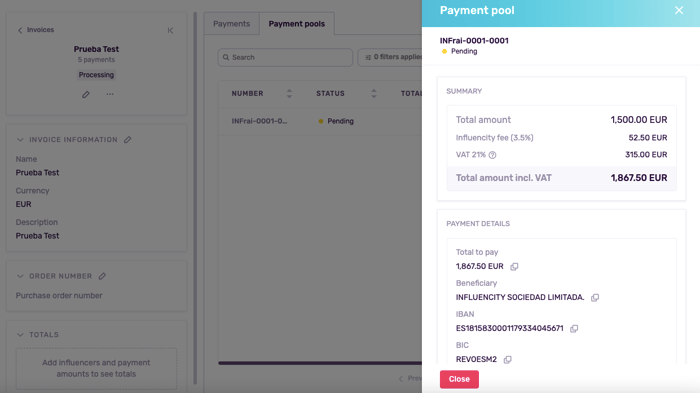Influencer contracts should feel like they’re built on trust. You’re building a relationship, not just placing a billboard or running a Google ad.
That mindset is reshaping how the smartest brands approach creator partnerships. And the language is catching up. More marketers are calling them collaboration agreements, a signal that we’re moving away from one-sided, take-it-or-leave-it terms and toward real, transparent partnerships.
This guide shows you how to craft clear, fair agreements that build trust from the start, with real-world examples from brands like Rare Beauty and tools to streamline your process.
1. What a Creator Collaboration Agreement Really Does
A smart collaboration agreement isn’t just legal housekeeping. It’s how you get everyone aligned from day one, including creators, your internal team, and any agency partners.
Done well, it cuts miscommunication, speeds approvals, and keeps your campaign running smoothly across teams, channels, or timelines.
2. Key Clauses Every Collaboration Agreement Needs
A good collaboration agreement is clean, clear, and campaign-specific. Below are the core clauses you should include in every legal agreement with a creator, whether you’re working with a nano creator or a big-name ambassador.
Scope of Work
Spell out exactly what’s expected:
- Platforms (Instagram, TikTok, YouTube, etc.)
- Number of posts, stories, or videos
- Caption length, hashtags, tags, swipe-ups
- Engagement (e.g., replying to comments)
- Any custom requirements like wardrobe guidelines or visual themes
Example: “1 Instagram Reel (30–60 seconds) featuring unboxing, posted by Oct. 5 with #GlowWithUs and product tag.”
Compensation & Payment Terms
Be crystal clear about how and when creators get paid. Include:
- Flat fee, gifted product, affiliate terms, or tiered bonuses
- Payment method and timing (e.g., 50% upfront, 50% on post approval)
- Reimbursement rules for expenses like travel or props
-4a988.png?width=700&height=148&name=White%20%26%20Green%20Modern%20Bar%20Chart%20Graph%20(4)-4.png)
Usage Rights & Content Ownership
Who owns the content and how can it be used?
This is one of the most important (and sensitive) parts of any collaboration agreement. If your terms are vague or overly broad, expect questions or for the creator to walk.
Be specific about:
- Where and how the brand can use the content
(e.g., organic social only, or including paid ads, Spark, whitelisting)
- How long those rights last
(e.g., 90 days, 6 months, 1 year)
- Whether the brand can edit, re-caption, or repurpose the content
for other channels or future campaigns.
Clear usage terms build confidence and make rollout easier for everyone.
If you want long-term or paid usage, spell it out and compensate accordingly. Respect and clarity here go a long way toward building trust.
Exclusivity Clauses
Protect your brand without boxing the creator in.
Exclusivity is a smart move. It ensures your sponsored content doesn’t compete with a shoutout for a rival brand a few scrolls away. But If your clause is too broad or vague, you’ll either lose the creator or end up paying far more than expected.
Here’s how to get it right:
- Category clarity
Skincare ≠ beauty ≠ haircare. Be specific about what you’re protecting.
- Timeframe
Spell out how long the non-compete window lasts. Common ranges are 7–30 days before and after the post date.
- Platform scope
Are you restricting only Instagram? Or does this apply to TikTok, YouTube, newsletters, or podcasts too?
Smart clause:“No sponsored skincare content 14 days before or after posting.”
That gives the creator a clear boundary without taking over their entire content calendar.
Need broader coverage (like 60 days across all platforms)? Be ready to negotiate. Creators are running businesses, too.

Content Review & Approval Flow
Build in brand-side deadlines, too. Creators can’t afford to wait five days for edits. A 48-hour turnaround shows respect for their time and keeps your campaign on schedule.
Real-Life Example: Glossier's Thoughtful Approval Process
Glossier’s influencer team is known for blending structure with flexibility. For creator-led campaigns, they set expectations upfront:
- 1 Round of feedback
- 48-hour brand turnaround
- Clear point of contact for signoff
Rather than micromanage tone or rewrite captions, Glossier trusts creators to speak authentically while staying within brand guidelines. The result is posts that feel real, not robotic, and campaigns that launch on time.

FTC Compliance & Disclosure
Help creators stay compliant without the guesswork.
- Spell out required hashtags: #ad, #sponsored
- Note platform-specific rules (e.g., paid partnership label on Instagram)
“Include #sponsored within the first 3 lines of caption or as on-screen text in Reels.”
Quick Checklist: 7 Must-Have Clauses in Every Creator Collaboration Agreement
Before you hit send, make sure your agreement covers:
- Scope of Work
Deliverables, formats, and expectations — at a glance.
- Payment Terms
How much, when, and how. Plus any reimbursement rules.
- Usage Rights
Where and how the brand can use the content (organic vs. paid, duration, edits).
- Content Ownership
Who owns the final asset, and whether the creator can repost or resell it.
- Exclusivity Windows
Restrictions on working with competing brands (and for how long).
- Approval Process
Deadlines for drafts, review windows, and revision rounds.
- FTC Compliance
Required disclosures (#ad, paid partnership tag, etc.) to stay compliant.
3. Red Flags in Creator Agreements
Vague Payment Terms
Creators need to know when and how they’ll be paid. “After the campaign ends” isn’t enough. Spell out the payment method, trigger (e.g., content approval), and timeline (e.g., 14 business days).

No FTC Disclosure Guidance
Leaving out disclosure requirements puts both parties at risk. Always include instructions on hashtags, platform tools (like Instagram’s paid partnership label), and where disclosures should appear.
No Creative Input or Feedback Loop
Rigid content demands with no room for creator input signal this is just a gig, not a partnership. Contracts should include space for creator voice and a feedback process, especially for longer campaigns.
Overreaching Exclusivity
If you’re asking for exclusivity, make it clear and time-bound. Broad or vague restrictions are a quick way to lose talent.
4. How Smart Brands Build Fair Agreements
Great influencer partnerships don’t feel transactional. They feel like true collaboration. Smart brands know a strong agreement doesn’t just protect the business. It builds trust, strengthens advocacy, and makes content easier to scale.
A standout example?
Brand Spotlight: Rare Beauty
Rare Beauty (founded by Selena Gomez) isn’t just known for inclusive products and mission-driven marketing. It’s also earned a strong reputation for how it treats creators.
Here’s what sets their influencer agreements apart:
- Transparent payment terms: Compensation is fair, clear, and paid on time.
- Defined but flexible deliverables: Campaigns come with structure, but creators have room to express themselves.
- Thoughtful usage rights: Rights are granted for specific platforms and durations, not “forever” without limits.
- Creator co-creation: Some agreements are built with influencer input, especially for ambassador programs.
Because Rare Beauty’s creators feel respected, not used, they often advocate for the brand even outside of paid campaigns.
Takeaway: Word spreads fast. Fair, respectful contracts turn your brand into one creators want to work with.
-307c8.png?width=700&height=449&name=White%20%26%20Green%20Modern%20Bar%20Chart%20Graph%20(5)-3.png)
6. Best Practices for Creative, Flexible Agreements
Even the most airtight contract won’t save a campaign if the process feels rigid or one-sided. That’s why the best agreements invite collaboration.
Here’s how to structure agreements that leave room for creativity and keep your campaign on track:
Invite Creator Input from the Start
Leave space in your scope of work for creators to propose formats, angles, or content hooks they know will land with their audience.
Instead of dictating “1 Instagram Reel,” try: “1 short-form video (Reel or TikTok), format based on creator’s preferred platform and style.”
Build in a Feedback Loop
Allow both sides to raise concerns mid-campaign, especially on longer-term partnerships. Creators appreciate a chance to flag what's working (and what’s not).
- Add a check-in clause after content delivery or halfway through the timeline.
- Encourage brands to provide constructive feedback and invite it in return.
Respect Creative Timelines
Many creators batch shoot content monthly or work with professional photographers on set dates. Last-minute changes or unclear deadlines can derail everything.
Best practice: Include a campaign timeline in the agreement, with room for reshoots or approvals, and share it up front.
Start with a Kickoff Call (Even for One-Offs)
Even a quick Zoom or Slack thread early on can save you weeks of back-and-forth.
Contracts build clarity. Calls build trust.
The best-written collaboration agreement can fall apart if it’s buried in someone’s inbox or forgotten during content review. That’s where Influencity comes in.
See exactly what was promised and what’s been delivered all in one view. You’ll always know if a post went live on time, if a bonus is due, or if usage terms need to be extended.
Never miss a deadline or payment trigger again. Influencity reminds your team (and your creators) about:
A collaboration agreement isn’t just paperwork. It’s the first real impression you make after a “yes.”
Get it right, and you’re creating a smoother creative process, stronger influencer relationships, and campaigns that are easier to scale and repeat.


-4a988.png?width=700&height=148&name=White%20%26%20Green%20Modern%20Bar%20Chart%20Graph%20(4)-4.png)



-307c8.png?width=700&height=449&name=White%20%26%20Green%20Modern%20Bar%20Chart%20Graph%20(5)-3.png)


